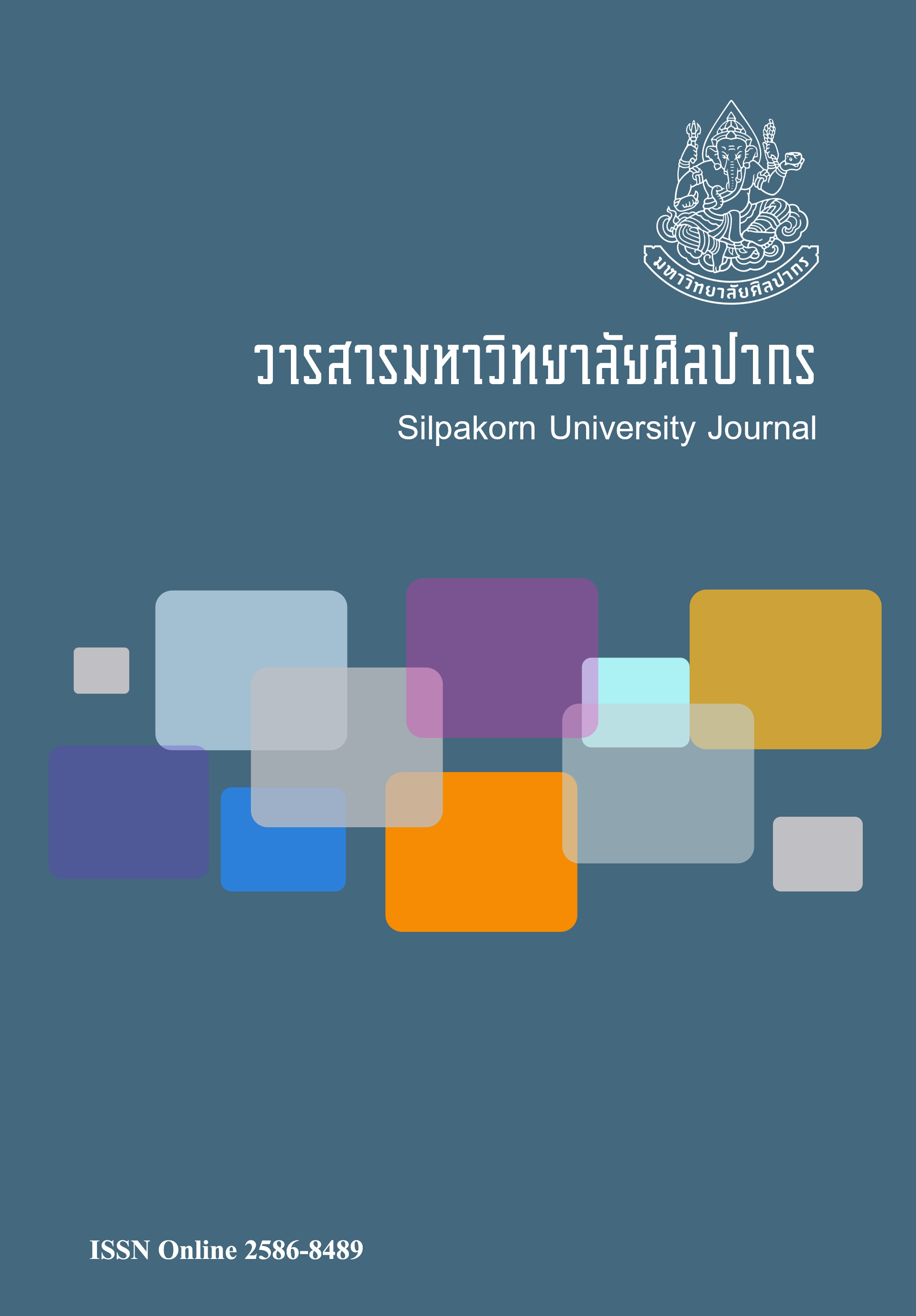เปรียบเทียบระบบเสียงภาษาภูเก็ตบ้าบ๋า และภาษามลายูบ้าบ๋าแนวร่วมสมัย (A synchronic comparison between the sound systems of Baba Phuket and Baba Malay)
Main Article Content
Abstract
บทความวิจัยนี้มีจุดมุ่งหมายเพื่อวิเคราะห์ระบบเสียงภาษาภูเก็ตบ้าบ๋า และเปรียบเทียบกับระบบเสียงภาษามลายูบ้าบ๋าที่เคยมีผู้ศึกษาไว้แล้ว โดยใช้รายการคำจำนวน 2,000 คำในแต่ละภาษาที่ตรึงคำแปลอธิบาย (gloss) ในภาษาอังกฤษและภาษาไทย ผลการวิจัยพบว่า ภาษาภูเก็ตบ้าบ๋ามีระบบเสียงคล้ายกับภาษาไทยถิ่นภูเก็ต ในขณะที่ภาษามลายูบ้าบ๋ามีระบบเสียงคล้ายกับภาษามลายูกลาง ภาษาภูเก็ตบ้าบ๋ามีพยัญชนะ 21 หน่วยเสียง ซึ่งเป็นพยัญชนะต้นได้ทุกหน่วยเสียง เป็นพยัญชนะท้ายได้ 9 หน่วยเสียง แต่มีพยัญชนะควบกล้ำ 10 เสียง ซึ่งน้อยกว่าภาษาไทยถิ่นภูเก็ต1 เสียง คือ ไม่มีเสียง /ml-/ ในระบบสระของภาษาภูเก็ตบ้าบ๋าพบความต่างอย่างมีนัยสำคัญระหว่างสระสั้นกับสระยาว โดยสระเดี่ยวมี 18 หน่วยเสียง และสระประสมมี 6 หน่วยเสียง ส่วนวรรณยุกต์มี 7 หน่วยเสียง ภาษามลายูบ้าบ๋ามีพยัญชนะ 19 หน่วยเสียง ซึ่งเป็นพยัญชนะต้นได้ทุกหน่วยเสียง เป็นพยัญชนะท้ายได้ 12 หน่วยเสียง มีสระเดี่ยว 8 หน่วยเสียง และสระประสม 2 หน่วยเสียง ภาษามลายูบ้าบ๋าเป็นภาษาไม่มีวรรณยุกต์เช่นเดียวกับภาษามลายูกลาง
This research aims to analyse and compare the sound systems between Baba Phuket (BP) and Baba Malay (BM) based on a corpus of 2,000 words. The research result reveals that the sound system of BP is similar to that of the Phuket dialect of Southern Thai (PST) while the sound system of BM is similar to that of Standard Malay (SM). There are 21 consonant phonemes in BP, all of which can occur in the initial position but 9 of them occur in the final position. BP has also 10 consonant clusters (CC-); unlike PST, it has no /ml-/. With regard to vowels, there are 18 monophthongs and 6 diphthongs. BP has contrastive vowel length. Like PST, BP has 7 tones. In BM, there are 19 consonant phonemes, all of which can occur in the initial position but 12 of them can occur in the final position. BM has 8 monophthongs and 2 diphthongs. Like SM, BM is a non-tonal language.
Downloads
Article Details
References
Guyarunsut, P. (1984). Chinese loanwords in current Thai (คำยืมภาษาจีนในภาษาไทยปัจจุบัน). Department of Linguistics, Faculty of Arts,Chulalongkorn University, Bangkok, Thailand.
Nala Huiying, L. (2014). A grammar of Baba Malay with sociophonetic consideration. Doctor of Philosophy in Linguistics, University of Hawaii , Manoa, United States of America.
Nuansanong, K. et al. (1984). Current Phuket Southern Thai dialect (ภาษาไทยถิ่นที่ใช้ในปัจจุบัน จังหวัดภูเก็ต). Department of Thai, Facultyof Humanities, Srinakharinwirot University, Songkhla, Thailand.
Pakir, A. (1986). A linguistic investigation of Baba Malay. Doctor of Philosophyin Linguistics, University of Hawai’i, Manoa, United States of America.
Ruengwiset, S. (1977). The phonemic system of Phuket Southern Thai dialect in Thepkasattri sub-district, Thalang district (ระบบหน่วยเสียงในภาษาถิ่น ตำบลเทพกษัตรีย์ อำเภอถลาง จังหวัดภูเก็ต). Master’s dissertation,Srinakharinwirot University, Bangkok, Thailand
Saleh, R.(1992). The standard of spelling system and pronunciation in Bahasa Malaysia (ภาษา มลายูกับความเป็นมาตรฐานของระบบการสะกดและการออกเสียง) (1st ed.). Department of Malay Studies, Faculty of Humanities, Srinakharinwirot University, Songkhla, Thailand.
Sasiwongsarot, K. (2000). Encyclopedia of ethnic groups in Thailand: Hokkien (สารานุกรมกลุ่มชาติพันธุ์ : ฮกเกี้ยน) (1st ed.). Bangkok: Sahathammic.
Shellabear, W.G.(1913). Baba Malay: an introduction to the language of the Straits-born Chinese. Journal of the Straits Branch of the Royal Asiatic Society, 65, 50-63.
Sonny, L. (1981). Baba Malay: the language of Strait-Born Chinese. Department of Linguistics, Master of Arts, Monash University, Australia.
Tan, C. B. (1988). The Baba of Melaka: culture and identity of a Chinese Peranakan community in Malaysia. Petaling Jaya: Pelanduk Publications.
Tantiwit, B., & Sapphasri Tantiwit, D. (2006). I’m a Baba Phuket(ผมเป็นบาบ๋าคนหนึ่ง เป็นบาบ๋าภูเก็ต) (1st ed.). Bangkok: Watthana printing Co,.Ltd.
Ansaldo, U.(2009). Contact languages: ecology and evolution in Asia (1st ed.). New York: Cambridge University Press.
Yimprasert, S. (2007).River of the past (สายธารแห่งอดีต) (1st ed.). Departmentof History, Faculty of Arts, Chulalongkorn University, Bangkok, Thailand.
Yupho, N (1989). Bahasa Malaysia pronunciation based on the roman alphabet, and the sound system of Bahasa Malaysia (การออกเสียงภาษามาเลเซียด้วยอักษรโรมันและระบบเสียงในภาษามาเลเซีย) (1st ed.). Nakhornpathom: Research Institute for Languages and Cultures of Asia, Mahidol University.


